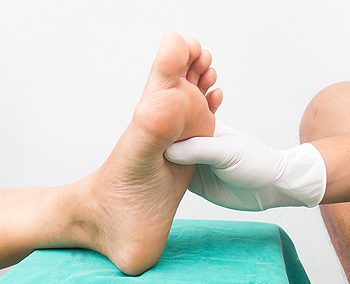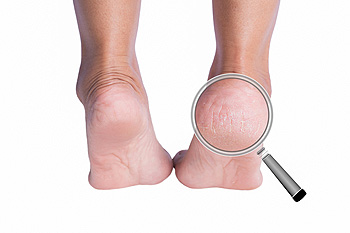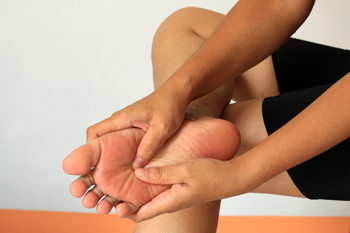July 2020
Treatment and Prevention for Corns
 Corns may develop as a natural protective measure against the pressure and friction endured by your feet. Over time, corns can become uncomfortable as the skin thickens, cracks, or becomes tender. If you have corns on your feet it is recommended to avoid taking long walks or standing for prolonged periods of time, as this could further aggravate the skin. To prevent corns, you may try wearing cushioned socks, wearing comfortable well-fitting shoes, using heel pads or insoles, regularly moisturizing your feet, and avoid walking barefoot. Seeing a podiatrist for your corns is also beneficial. A podiatrist can recommend appropriate footwear, remove callused skin, and prescribe additional treatments to reduce your pain and prevent corns from recurring in the future.
Corns may develop as a natural protective measure against the pressure and friction endured by your feet. Over time, corns can become uncomfortable as the skin thickens, cracks, or becomes tender. If you have corns on your feet it is recommended to avoid taking long walks or standing for prolonged periods of time, as this could further aggravate the skin. To prevent corns, you may try wearing cushioned socks, wearing comfortable well-fitting shoes, using heel pads or insoles, regularly moisturizing your feet, and avoid walking barefoot. Seeing a podiatrist for your corns is also beneficial. A podiatrist can recommend appropriate footwear, remove callused skin, and prescribe additional treatments to reduce your pain and prevent corns from recurring in the future.
Corns can make walking very painful and should be treated immediately. If you have questions regarding your feet and ankles, contact one of our podiatrists of Advanced Foot & Ankle Associates, PLLC. Our doctors will treat your foot and ankle needs.
Corns: What Are They? And How Do You Get Rid of Them?
Corns are thickened areas on the skin that can become painful. They are caused by excessive pressure and friction on the skin. Corns press into the deeper layers of the skin and are usually round in shape.
Ways to Prevent Corns
There are many ways to get rid of painful corns such as:
- Wearing properly fitting shoes that have been measured by a professional
- Wearing shoes that are not sharply pointed or have high heels
- Wearing only shoes that offer support
Treating Corns
Although most corns slowly disappear when the friction or pressure stops, this isn’t always the case. Consult with your podiatrist to determine the best treatment option for your case of corns.
If you have any questions please feel free to contact one of our offices located in Lake Worth and Aledo/Willow Park, TX . We offer the newest diagnostic and treatment technologies for all your foot and ankle needs.
Reminder: When Was the Last Time...?
Vascular Testing with a Podiatrist
 Vascular testing is used by podiatrists to make sure that there is adequate blood flow to your lower limbs. Reduced blood flow can be dangerous if left undiagnosed and untreated. Vascular testing may be performed if you are experiencing pain, numbness, or weakness in your legs, have poorly healing wounds, or have a history of diabetes or cardiovascular disease. Vascular tests are generally noninvasive and painless. The doctor may perform an ultrasound of your legs and feet, check your pulse by hand, measure and compare the blood pressures of your arm and ankle, and perform a visual examination of your lower limbs. If you suspect that you may have reduced blood flow to your legs, discuss it with your podiatrist today.
Vascular testing is used by podiatrists to make sure that there is adequate blood flow to your lower limbs. Reduced blood flow can be dangerous if left undiagnosed and untreated. Vascular testing may be performed if you are experiencing pain, numbness, or weakness in your legs, have poorly healing wounds, or have a history of diabetes or cardiovascular disease. Vascular tests are generally noninvasive and painless. The doctor may perform an ultrasound of your legs and feet, check your pulse by hand, measure and compare the blood pressures of your arm and ankle, and perform a visual examination of your lower limbs. If you suspect that you may have reduced blood flow to your legs, discuss it with your podiatrist today.
Vascular testing plays an important part in diagnosing disease like peripheral artery disease. If you have symptoms of peripheral artery disease, or diabetes, consult with one of our podiatrists from Advanced Foot & Ankle Associates, PLLC. Our doctors will assess your condition and provide you with quality foot and ankle treatment.
What Is Vascular Testing?
Vascular testing checks for how well blood circulation is in the veins and arteries. This is most often done to determine and treat a patient for peripheral artery disease (PAD), stroke, and aneurysms. Podiatrists utilize vascular testing when a patient has symptoms of PAD or if they believe they might. If a patient has diabetes, a podiatrist may determine a vascular test to be prudent to check for poor blood circulation.
How Is it Conducted?
Most forms of vascular testing are non-invasive. Podiatrists will first conduct a visual inspection for any wounds, discoloration, and any abnormal signs prior to a vascular test.
The most common tests include:
- Ankle-Brachial Index (ABI) examination
- Doppler examination
- Pedal pulses
These tests are safe, painless, and easy to do. Once finished, the podiatrist can then provide a diagnosis and the best course for treatment.
If you have any questions, please feel free to contact one of our offices located in Lake Worth and Aledo/Willow Park, TX . We offer the newest diagnostic and treatment technologies for all your foot care needs.
How do Cracked Heels Develop?
 Fissures, also known as deep cracks, can develop in the skin of the heel. They can cause pain and discomfort, and in severe cases, bleeding may occur. Cracked heels can develop as a result of dry skin, but can also be caused due to a variety of reasons. These can include standing on hard surfaces for the majority of the day, or from specific medical conditions such as psoriasis and eczema. Additionally, patients who are overweight may develop this condition as a result of the added weight the feet endure. Many patients find mild relief when the feet are soaked in warm water, followed by applying a good moisturizer. If you have cracked heels, it is suggested that you schedule an appointment with a podiatrist who can guide you toward proper maintenance advice and possible prevention techniques.
Fissures, also known as deep cracks, can develop in the skin of the heel. They can cause pain and discomfort, and in severe cases, bleeding may occur. Cracked heels can develop as a result of dry skin, but can also be caused due to a variety of reasons. These can include standing on hard surfaces for the majority of the day, or from specific medical conditions such as psoriasis and eczema. Additionally, patients who are overweight may develop this condition as a result of the added weight the feet endure. Many patients find mild relief when the feet are soaked in warm water, followed by applying a good moisturizer. If you have cracked heels, it is suggested that you schedule an appointment with a podiatrist who can guide you toward proper maintenance advice and possible prevention techniques.
If the skin on your feet starts to crack, you may want to see a podiatrist to find treatment. If you have any concerns, contact one of our podiatrists from Advanced Foot & Ankle Associates, PLLC. Our doctors can provide the care you need to keep you pain-free and on your feet.
Cracked Heels
It is important to moisturize your cracked heels in order to prevent pain, bleeding, and infection. The reason cracked heels form is because the skin on the foot is too dry to support the immense pressure placed on them. When the foot expands, the dry skin on the foot begins to split.
Ways to Help Heal Them
- Invest in a good foot cream
- Try Using Petroleum Jelly
- Ease up on Soaps
- Drink Plenty of Water
Ways to Prevent Cracked Heels
- Moisturize After Showering
- Skip a Shower
- Keep Shower Water Lukewarm
- Don’t Scrub Your Feet
If you are unsure how to proceed in treating cracked heels, seek guidance from a podiatrist. Your doctor will help you with any questions or information you may need.
If you have any questions, please feel free to contact one of our offices located in Lake Worth and Aledo/Willow Park, TX . We offer the newest diagnostic and treatment technologies for all your foot care needs.
Numbing Sensation in the Feet and Toes
 Experiencing a numbing sensation in the feet and toes can be an indicator of Peripheral Artery Disease, also known as PAD. This condition typically develops due to a build-up of fatty deposits on the walls of the arteries. The numbing sensation that is often associated with this condition can be incredibly dangerous, as it can prevent patients from feeling or recognizing injuries to the feet. Scrapes and wounds that are left undetected may lead to an infection. Along with experiencing a numbness in the lower extremity regions, patients with PAD have also noted experiencing symptoms such as coldness and discoloration of the legs and feet. In order to safely treat PAD, please seek the professional care of a podiatrist.
Experiencing a numbing sensation in the feet and toes can be an indicator of Peripheral Artery Disease, also known as PAD. This condition typically develops due to a build-up of fatty deposits on the walls of the arteries. The numbing sensation that is often associated with this condition can be incredibly dangerous, as it can prevent patients from feeling or recognizing injuries to the feet. Scrapes and wounds that are left undetected may lead to an infection. Along with experiencing a numbness in the lower extremity regions, patients with PAD have also noted experiencing symptoms such as coldness and discoloration of the legs and feet. In order to safely treat PAD, please seek the professional care of a podiatrist.
Peripheral artery disease can pose a serious risk to your health. It can increase the risk of stroke and heart attack. If you have symptoms of peripheral artery disease, consult with one of our podiatrists from Advanced Foot & Ankle Associates, PLLC. Our doctors will assess your condition and provide you with quality foot and ankle treatment.
Peripheral artery disease (PAD) is when arteries are constricted due to plaque (fatty deposits) build-up. This results in less blood flow to the legs and other extremities. The main cause of PAD is atherosclerosis, in which plaque builds up in the arteries.
Symptoms
Symptoms of PAD include:
- Claudication (leg pain from walking)
- Numbness in legs
- Decrease in growth of leg hair and toenails
- Paleness of the skin
- Erectile dysfunction
- Sores and wounds on legs and feet that won’t heal
- Coldness in one leg
It is important to note that a majority of individuals never show any symptoms of PAD.
Diagnosis
While PAD occurs in the legs and arteries, Podiatrists can diagnose PAD. Podiatrists utilize a test called an ankle-brachial index (ABI). An ABI test compares blood pressure in your arm to you ankle to see if any abnormality occurs. Ultrasound and imaging devices may also be used.
Treatment
Fortunately, lifestyle changes such as maintaining a healthy diet, exercising, managing cholesterol and blood sugar levels, and quitting smoking, can all treat PAD. Medications that prevent clots from occurring can be prescribed. Finally, in some cases, surgery may be recommended.
If you have any questions, please feel free to contact one of our offices located in Lake Worth and Aledo/Willow Park, TX . We offer the newest diagnostic and treatment technologies for all your foot care needs.
Read more about Peripheral Artery DiseaseBlog Archives
- May 2025
- April 2025
- March 2025
- February 2025
- January 2025
- December 2024
- November 2024
- October 2024
- September 2024
- August 2024
- July 2024
- June 2024
- May 2024
- April 2024
- March 2024
- February 2024
- January 2024
- December 2023
- November 2023
- October 2023
- September 2023
- August 2023
- July 2023
- June 2023
- May 2023
- April 2023
- March 2023
- February 2023
- January 2023
- December 2022
- November 2022
- October 2022
- September 2022
- August 2022
- July 2022
- June 2022
- May 2022
- April 2022
- March 2022
- February 2022
- January 2022
- December 2021
- November 2021
- October 2021
- September 2021
- August 2021
- July 2021
- June 2021
- May 2021
- April 2021
- March 2021
- February 2021
- January 2021
- December 2020
- November 2020
- October 2020
- September 2020
- August 2020
- July 2020
- June 2020
- May 2020
- April 2020
- March 2020
- February 2020
- January 2020
- December 2019
- November 2019
- October 2019
- September 2019
- August 2019
- July 2019
- June 2019
- May 2019
- April 2019
- March 2019
- February 2019
- January 2019
- December 2018
- November 2018
- October 2018





